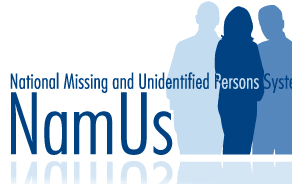NamUs: Partnering Law Enforcement, Medical Professions, and the Community to Solve Missing and Unidentified Persons Cases
According to data put out by the Department of Justice, Office of Justice Program’s Bureau of Justice Statistics, in a typical year, medical examiners and coroners will handle approximately 4,400 unidentified person cases. On average, 1,000 of these cases remain unidentified and become cold cases.
 The National Missing and Unidentified Persons System (NamUs) was developed as a result of the 2005 National Institute of Justice “Identifying the Missing Summit.” This meeting brought together federal, state, and local law enforcement officials, medical examiners and coroners, forensic scientists, key policymakers, victim advocates, and families from around the country to develop a national strategy to address the major challenges related to investigating and solving missing persons and unidentified decedent cases. After the national strategy meeting was held, the U.S. Department of Justice was charged with identifying every existing tool, and developing new tools, to help solve these cases.
The National Missing and Unidentified Persons System (NamUs) was developed as a result of the 2005 National Institute of Justice “Identifying the Missing Summit.” This meeting brought together federal, state, and local law enforcement officials, medical examiners and coroners, forensic scientists, key policymakers, victim advocates, and families from around the country to develop a national strategy to address the major challenges related to investigating and solving missing persons and unidentified decedent cases. After the national strategy meeting was held, the U.S. Department of Justice was charged with identifying every existing tool, and developing new tools, to help solve these cases.
A major component of this initiative was to develop a system that would improve information access for all the people who might be able to help solve these cases. And thus, NamUs was created.
NamUs is a national centralized repository and resource center for missing persons and unidentified decent records. The NIJ-funded program is currently managed in partnership with a team at the University of North Texas Health Science Center (UNTHSC), composed of forensic specialists, former law enforcement officials, and other criminal justice professionals. NamUs is a free online system that is accessible to law enforcement officials, medical professionals, and community members from across the nation in hopes of resolving these cases through collaboration, correction of critical data, and information sharing efforts. According to the NamUs website, the system comprises three databases that address the different kinds of cases:
The Missing Persons Database:
This database contains information about missing persons that can be entered by anyone. However, the information is vetted and verified by law enforcement before it appears on the website as an open case. NamUs also provides a number of services and resources to its users, including the ability to print missing persons posters and receive free biometric collection and testing assistance. Other resources include links to state clearinghouses, medical examiner and coroner offices, law enforcement agencies, victim assistance groups, and pertinent legislation.
The Unidentified Persons Database:
 This database contains information entered by medical examiners and coroners. Unidentified persons are people who have died but have never been identified. All members of the community are able to search the database using characteristics such as sex, race, distinct body features, and even dental information.
This database contains information entered by medical examiners and coroners. Unidentified persons are people who have died but have never been identified. All members of the community are able to search the database using characteristics such as sex, race, distinct body features, and even dental information.
The UnClaimed Persons Database:
This is a newly added database that contains information about deceased persons who have been identified by name, but for whom no next of kin or family member has been identified or located to claim the body for burial or other disposition. Only medical examiners and coroners are able to enter cases into the UCP database. However, the database is searchable by the public when using a missing person’s name and year of birth.
One of the useful functions of the NamUs system is that when a new missing persons or unidentified decedent case is entered, the system automatically performs cross-matching comparisons between the databases, searching for matches or similarities between cases. Further, NamUs at UNTHSC provides free DNA testing and other forensic services, such as anthropology, odontology, and fingerprint analysis assistance.
While NamUs provides law enforcement with a plethora of valuable resources to help solve these cases, equally important is how the system functions as a way of supporting communities across the United States who are dealing with the crisis of unresolved missing persons and unidentified decedent cases. To date, there have been a number of successful matches made through the efforts of the public using NamUs to search for loved ones, or identify similarities between missing persons and unidentified persons cases.
With law enforcement agencies being forced to slash budgets because of the current economic conditions, many have no choice but to cut training and technology. NamUs helps by providing training and technical assistance to law enforcement agencies nationwide, as well as a multitude of other resources, all at no cost.
To access the NamUs system, visit www.namus.gov and select “register” to customize a user profile. Following registration, a system administrator located in your agency’s region will begin the vetting process and become the primary contact to assist you with any information relating to NamUs. Once verified as law enforcement, the user is granted unlimited access to case information that is not disclosed to the general public.
Dustin Driscoll, NamUs Analyst
Jessica Mansourian, Program Analyst, COPS Office
SUCCESS STORY:A detective from the Maricopa County Sheriff’s Office in Phoenix, Arizona, worked with the NamUs analyst for technical assistance on a 1987 John Doe case. The decedent was thought to be a juvenile between 15 and 17 years of age, and was likely a runaway, as he was found while hitchhiking across the country. He was involved in an automobile accident while riding with an adult male who claimed he did not know the child’s true identity, but stated the child was using the name Brian Moore. No report of a missing person named Brian Moore ever surfaced and this was later thought to be an alias.The analyst used the physical description of the decedent to conduct searches against missing person records that have been purged from the National Crime Information Center (NCIC). The analyst located a record for John Bryan Moore, a California teen whose record was purged from NCIC prior to the discovery of the decedent. After alerting the detective of the potential match, John Bryan Moore’s family was contacted and verified that he had not been seen since 1987. DNA samples were provided by the family and confirmed John Bryan Moore’s identity. |
Police and People Who Stutter | Partnerships for Preparedness | Events with the Potential to Go Viral | Tribal Policing Partnerships | Solving Missing and Unidentified Persons Cases | Advancing Police Legitimacy | Did you know…?
